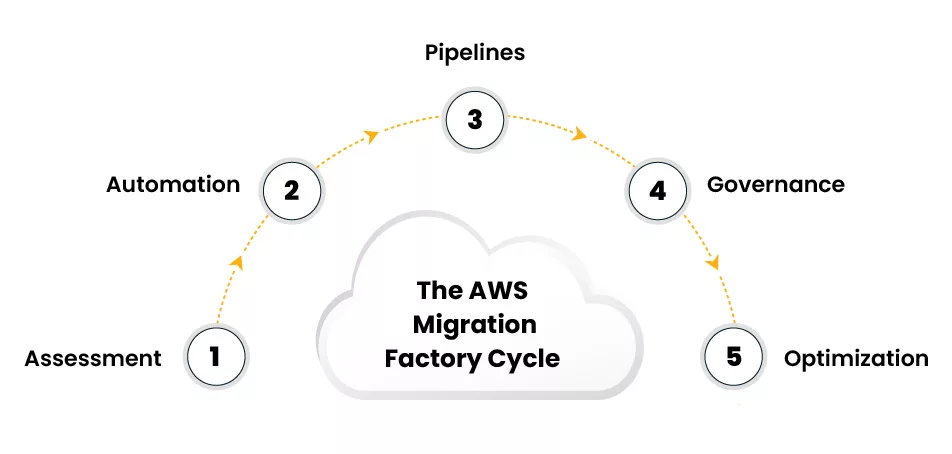Anyone who has ever tried to move a large application portfolio to the cloud knows the early enthusiasm fades fast. The first few workloads go well, and then you hit the messy ones. Dependencies you did not know about start showing up. Teams realize the cutover paths aren’t the same for every system. People argue over timelines. Someone discovers a database no one remembered existed. That’s usually when leadership starts asking why this entire thing seems stuck.
What helped in my programs was stepping back and treating migration like a production workflow instead of a collection of one-off tasks. That shift led me to what many now call an AWS migration factory, which transformed how teams approached modernization through structured AWS migration services. The factory model isn’t magical, but it gives structure in a place where chaos usually wins.
What follows isn’t textbook theory. It’s a blend of real patterns, mistakes, and things I’ve learned the hard way from moving hundreds of workloads.
Getting clear on what you’re trying to fix
Most organizations don’t fall behind because of technology problems. They fall behind because their process collapses under scale. The migration might start with ten applications, but soon you’re looking at forty more. Then someone wants to insert modernization work into the same pipeline, and the entire effort loses direction.
That’s when the idea of a AWS migration factory starts to feel less like a buzzword and more like the missing piece. The point of the factory is simple. You want a structured, predictable system that takes an application from assessment to cutover in a way that doesn’t change every week. You also want something that sets you up for long-term AWS modernization, since no enterprise moves just once. Cloud maturity is a continuous effort, and the factory model supports that.
A question I’ve heard many times is “How does an AWS migration factory work?” It usually comes from teams who know they need a better approach but don’t know where to start. The short answer is that it works by removing randomness. The longer answer is what the rest of this guide explains.
Starting with objectives that actually matter
In my early projects, we made the mistake of listing objectives that sounded impressive but didn’t influence daily work. Over time, I learned that practical objectives are the ones that keep the factory dependent on the workforce. Here are the ones that consistently helped:
- Keep delivery predictable.
- Make assessments structured, not subjective.
- Automate anything that repeats.
- Use consistent quality gates.
- Make decisions visible to everyone involved.
If your goal includes supporting ongoing AWS modernization, spell that out early. The migration and modernization tracks should not be separate conversations. The factory model ties them together.
Why does assessment matter more than most people admit?
People often underestimate the assessment step because it feels like paperwork. In reality, this phase decides whether the rest of your plan works. If your assessments are weak, your timelines will be wrong, your complexity scores will be off, and your wave planning will fall apart.
Here is what I eventually standardized for assessments:
- A single intake questionnaire everyone used
- A complexity scoring scale that didn’t change mid-project
- Clear guidelines for identifying modernization candidates
- A documented dependency map
- Early tagging so workloads could move through the pipeline in groups
You’d be surprised how often the question is: How does an AWS migration factory work? Resurfaces during the assessment phase. Once teams see that every application enters the factory through the same intake path, the process stops looking ambiguous.
Structured assessments also support enterprise AWS modernization best practices, because you can easily identify which workloads can benefit from replatforming or refactoring later in the journey.
Here is a simplified visual we used:
Application Intake
↓
Discovery + Dependency Mapping
↓
Complexity Rating
↓
Migration Pattern
↓
Wave AssignmentThis diagram might look basic, but it gave clarity to teams who were juggling hundreds of moving parts.
Automation: the step that separates scalable projects from chaotic ones
If a migration involves more than a handful of workloads, manual work becomes your enemy. Manual steps are slow, and worse, they change depending on who performs them. That inconsistency causes quality issues and delays.
Over time, I leaned heavily on cloud migration automation tools to reduce manual errors and accelerate cutovers. They weren’t just for convenience. They allowed us to build repeatable cloud migration processes that didn’t collapse under pressure.
The tasks that most benefited from automation were:
- Landing zone provisioning
- Infrastructure templates
- Data migration routines
- Test scenario generation
- Cutover checklists
- Post-migration validation
Automation also played a big part in how we planned modernization. When workloads were already following automated paths, it became easier to insert steps that supported AWS modernization without disrupting everything else.
A diagram that worked well in practice looked like this:
Trigger
↓
Automated Landing Zone Setup
↓
Automated Data Migration
↓
Predefined Test Plans
↓
Cutover Execution
↓
ValidationAutomation gives the factory its rhythm. Without it, you’re just coordinating spreadsheets.
Building migration pipelines that don’t collapse under load
If someone asked me to name the single most important component of a AWS migration factory, I’d say pipelines. Assessments identify what you need to do, and automation helps make it consistent, but the pipeline is where the actual movement happens.
My pipeline design usually followed a pattern like this:
- Intake approval
- Preparation and environment setup
- Move phase
- Application testing
- Cutover
- Stabilization and optimization
Each application traveled through the same stages, following a structured cloud migration pipeline that allowed multi-wave execution. You don’t need perfection. You need consistency.
The pipeline also supported repeatable cloud migration processes, which later made modernization initiatives smoother. When teams saw how predictable migration had become, they understood how the same logic could guide AWS modernization.
Governance is not bureaucracy when done correctly
Governance has a bad reputation. Many engineers think it slows down work, and sometimes they’re right. But in a migration factory, governance is what keeps you from drifting away from your plan.
In most programs, governance included:
- A program office controlling priorities
- Clear gate reviews
- Security and compliance standards
- A way to track risk items
- Shared dashboards
- A weekly migration-wave review meeting
This structure helped us maintain a cloud governance framework, ensuring migration decisions supported broader modernization goals. Every choice connected back to a larger plan for the organization.
Here is a simple visual that represented our governance approach:
Program Office
↓
Security + Compliance Rules
↓
Wave Controls + Quality Gates
↓
Decision FrameworkIt wasn’t strict for the sake of it. Governance existed to keep noise out of the pipeline.
What happens after migration matters even more?
A mistake many companies make is believing the work ends once a workload lands on AWS. In practice, the post-migration period is where the most important improvements happen. If you want your cloud program to mature, you need to focus on this stage.
Optimization tasks included:
- Reviewing cost patterns
- Adjusting instance sizes
- Evaluating opportunities for managed services
- Setting up monitoring properly
- Running backup and recovery checks
- Enforcing tagging rules
- Preparing candidates for AWS modernization
This stage was also where teams decided which workloads were ready for containerization, which ones could move to serverless, and which ones needed deeper refactoring.
The optimization layer gave the AWS migration factory long-term value. It only moved workloads. It prepared them for a more modern architecture.
How does a migration factory accelerate modernization?
You can move workloads without a factory, but you can’t move them at scale without AWS cloud engineering services, which bring structure and scalability to modernization. And you definitely can’t set up a multi-year AWS modernization roadmap unless your migration approach is steady enough to support incremental improvements.

Here’s why the factory model directly supports modernization:
- Assessments uncover candidates early
- Automation keeps teams from drowning in repetitive chores
- Pipelines add structure to every wave
- Governance keeps decisions aligned
- Optimization prepares workloads for future upgrades
Once all of these pieces come together, the organization gains a repeatable rhythm. That rhythm becomes the backbone of long-term modernization.
Wrapping it up
Every migration program I’ve led or supported had its own complications. But one thing stayed consistent. The teams that built a proper AWS migration factory moved faster, made fewer mistakes, and stayed more aligned over time. They also made steady progress toward AWS modernization because the foundation was strong enough to handle ongoing improvements. There is no shortcut to building a migration factory. But once it exists, the benefits compound. You get clarity where there used to be confusion. You get predictable movement instead of stalled conversations. And you get a path that teams can follow even when the portfolio size grows.











